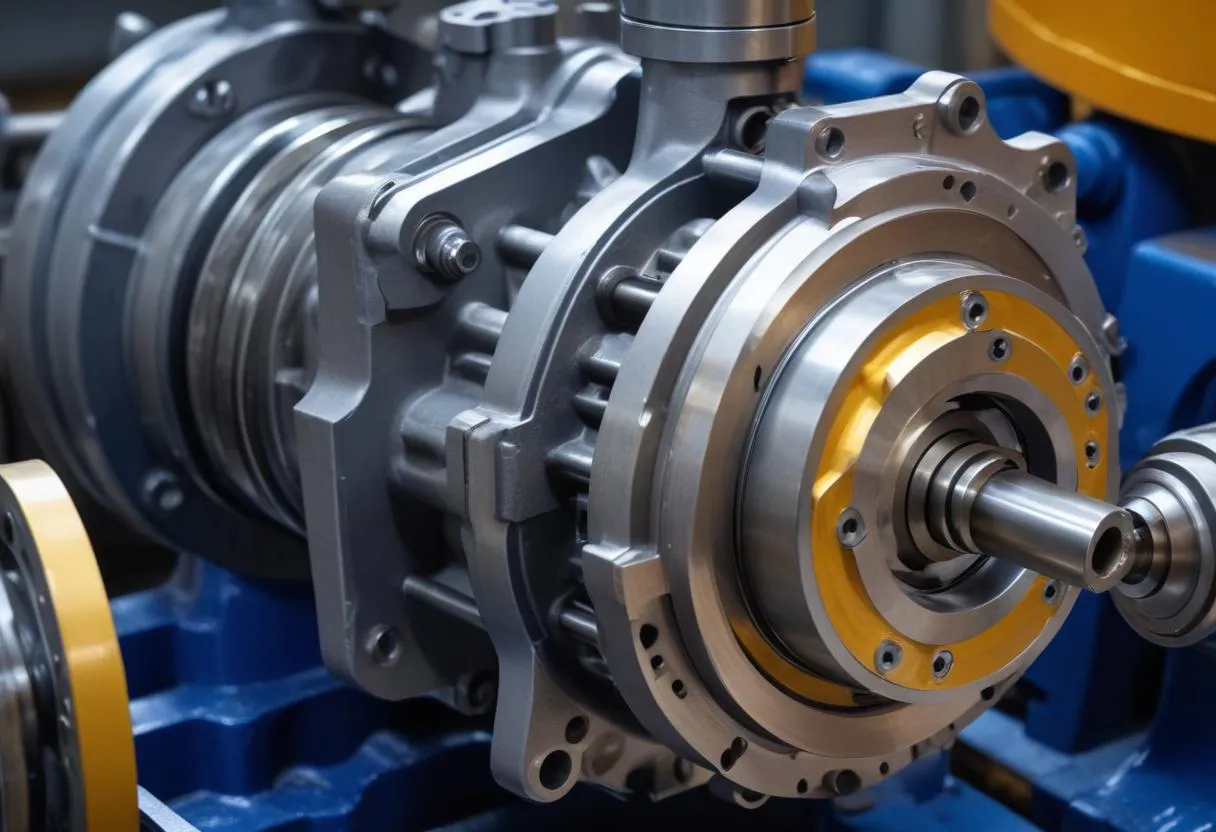 Positive displacement pumps are engineered to allow fluid to move by trapping a fixed amount and forcing (displacing) that trapped volume into the discharge pipe. Unlike centrifugal pumps, positive displacement pumps are capable of maintaining flow despite variations in system pressure, which makes them ideal for applications requiring consistent flow rates. They come in several types, including reciprocating and rotary, each with its own unique mechanics.
Positive displacement pumps are engineered to allow fluid to move by trapping a fixed amount and forcing (displacing) that trapped volume into the discharge pipe. Unlike centrifugal pumps, positive displacement pumps are capable of maintaining flow despite variations in system pressure, which makes them ideal for applications requiring consistent flow rates. They come in several types, including reciprocating and rotary, each with its own unique mechanics.
Reciprocating Pumps: These pumps function through a back-and-forth (reciprocating) movement of a piston within a cylinder, which alternately creates suction and discharge strokes. During the suction stroke, the piston moves backward, lowering the pressure in the cylinder, thus allowing the fluid to enter. As the piston moves forward during the discharge stroke, it compresses the fluid and pushes it out of the discharge valve. Key components include pistons, a cylinder, suction and discharge valves, and a crankshaft to drive the piston’s movement.
Rotary Pumps: Rotary pumps utilize gears, lobes, screws, or vanes on a rotor, which rotate inside a casing. As the rotating parts create voids, fluid moves into the pump. The rotation then displaces this fluid to the pump’s outlet. Common types include gear, lobe, screw, and vane pumps. Each type offers different characteristics, such as flow rate and efficiency, impacting suitability for various applications.
The operation of positive displacement pumps is fundamentally distinct in handling highly viscous fluids or fluids containing suspended or sensitive solids due to minimal shear forces and excellent volumetric efficiency. For both reciprocating and rotary pumps, maintaining a steady, pulsation-free flow often requires additional components such as pulsation dampeners in reciprocating pumps and flexible vanes in vane pumps, which adjust to varying conditions to maintain pump efficiency and prolong lifespan.
- Understanding Clearances: Internal clearances in these pumps are crucial, as they determine the efficiency of the pump by affecting the slip (leakage of fluid from discharge to suction side). Tighter clearances provide better efficiency but increase the risk of wear when pumping abrasive fluids.
- Effect of Viscosity: Higher fluid viscosity generally leads to improved sealing and decreased slip, enhancing the pump’s efficiency. However, extreme viscosities might require additional power to move the fluid, impacting pump selection and energy costs.
- Temperature Effects: Temperature variations can affect the physical properties of the fluid and the pump materials, potentially altering clearances and efficiency.
Maintaining an in-depth understanding of these mechanics not only facilitates more informed pump selection but also guides effective maintenance and troubleshooting strategies, ensuring the long-term reliability and efficiency of the pump system. Understanding how different components interact, and under what conditions, can help in preemptively addressing wear and tear, thereby maximizing the lifespan and performance of positive displacement pumps.
Routine maintenance best practices
Routine maintenance is vital to prevent deterioration in positive displacement pumps and ensure efficient operation. Implementing best practices can extend the life of the pump, reduce downtime, and decrease the frequency of costly repairs. Here are some key maintenance strategies:
- Lubrication: Regular lubrication of moving parts such as bearings, gears, and rotors is essential to minimize friction and wear. Use manufacturer-recommended oils and greases, and adhere to the prescribed lubrication schedules.
- Seal Replacement: Check seals and gaskets regularly for signs of wear or leakage. Replacing seals before they fail can prevent catastrophic failures and expensive secondary damage to the pump and surrounding equipment.
- Inspection Schedules: Conduct scheduled inspections to monitor and assess the condition of critical pump components. This includes checking for excessive noise, vibration, and temperature abnormalities that might indicate an underlying issue.
- Cleaning: Keep the pump and its components clean. Accumulation of debris can lead to reduced efficiency and eventual breakdown. This is particularly important in pumps handling solids or viscous fluids, as these materials can clog or erode internal parts.
- Component Adjustments: Regularly verify that all components are adjusted correctly according to the manufacturer’s specifications. Misalignment, improper tension in belts, or incorrect setting of pressure valves can lead to inefficient operation and increased wear.
Implementing these maintenance tasks requires detailed record-keeping and tracking of all activities related to the upkeep of the pump:
| Maintenance Activity | Frequency | Key Indicators |
|---|---|---|
| Lubrication | Monthly/As recommended | Smooth operation, no unusual noise |
| Seal Check | Bi-annual | No visible leaks, stable pressure performance |
| Inspection | Quarterly | Operational efficiency, vibration levels |
| Cleaning | After every use with solids or high-viscosity fluids | Clean internal components, unblocked lines |
| Component Adjustment | Annually/As needed | Correct alignment, tension, and settings |
Following these best practices not only maintains the optimal performance of positive displacement pumps but also prevents the progression of wear and tear. These activities should be incorporated into the everyday operational protocols, and staff should be trained accordingly to identify and address potential issues before they escalate into significant problems. Proper maintenance is a crucial strategy in maximizing both the efficiency and the lifespan of these pumps.
Advanced protective measures and technologies
 In the pursuit of extended operational life and optimal functioning of positive displacement pumps, incorporating more advanced protective measures and technologies is essential. These approaches utilize cutting-edge solutions and can provide substantial benefits over and above routine maintenance practices.
In the pursuit of extended operational life and optimal functioning of positive displacement pumps, incorporating more advanced protective measures and technologies is essential. These approaches utilize cutting-edge solutions and can provide substantial benefits over and above routine maintenance practices.
Vibration Analysis: One of the most effective methods to predict issues before they lead to failure is through vibration analysis. Specialized sensors and software monitor the vibrational patterns of a pump during operation. These patterns are analyzed to identify anomalies that precede failures, such as imbalances or bearing failures. Being proactive in this area helps prevent downtime and expensive repairs.
Thermal Imaging: Employing thermal imaging technologies can significantly aid in detecting overheating issues, which are precursors to many mechanical failures. This method allows maintenance teams to visualize areas of excess heat in a pump, often caused by issues like excessive friction, improper lubrication, or seal failure. Early detection is key to resolving these problems before they exacerbate.
Sensor Installation: The integration of various sensors into the pump system ensures continuous monitoring and data collection. Sensors can track pressure changes, temperature, flow rates, and even chemical changes within the fluid being pumped. This data can be transmitted in real-time to monitoring systems, allowing for rapid response to any signs of wear or system failure.
Automation and Control Systems: Implementing automated control systems can drastically reduce the wear and tear on pumps. These systems can adjust pump operation based on real-time data inputs like flow rate and pressure requirements, ensuring the pump operates only at necessary capacities and reducing unnecessary strain.
- Use of High-Performance Materials: Applying components made from advanced materials can also reinforce pump durability. For example, ceramic or alloy coatings on internal components that are resistant to abrasion and corrosion can maintain optimal clearance and minimize deterioration.
- Installation of Dampeners: Particularly in reciprocating pumps, the use of pulsation dampeners helps in smoothing the pulsation waves caused during the pumping cycle, therefore reducing mechanical stress and extending the pump’s lifespan.
- Slip Adjustment Mechanisms: Advanced pumps often include features that allow for the dynamic adjustment of slip to improve efficiency. These mechanisms adjust internal clearances automatically based on the operational parameters, maintaining optimal efficiency even under varying load conditions.
- Self-Lubricating Systems: Integrating a self-lubricating system ensures continuous and correct lubrication, which is crucial for minimizing friction between moving parts and thus reducing wear.
In summary, by leveraging advanced protective measures and making use of sophisticated technologies, operators can not only enhance the operational life of positive displacement pumps but also optimize their performance. This targeted approach focusing on prevention rather than corrective maintenance helps in significant cost savings in the long term by averting potential failures and minimizing downtime. Implementing these advanced measures should be seen as an investment into the longevity and efficiency of the pump systems.